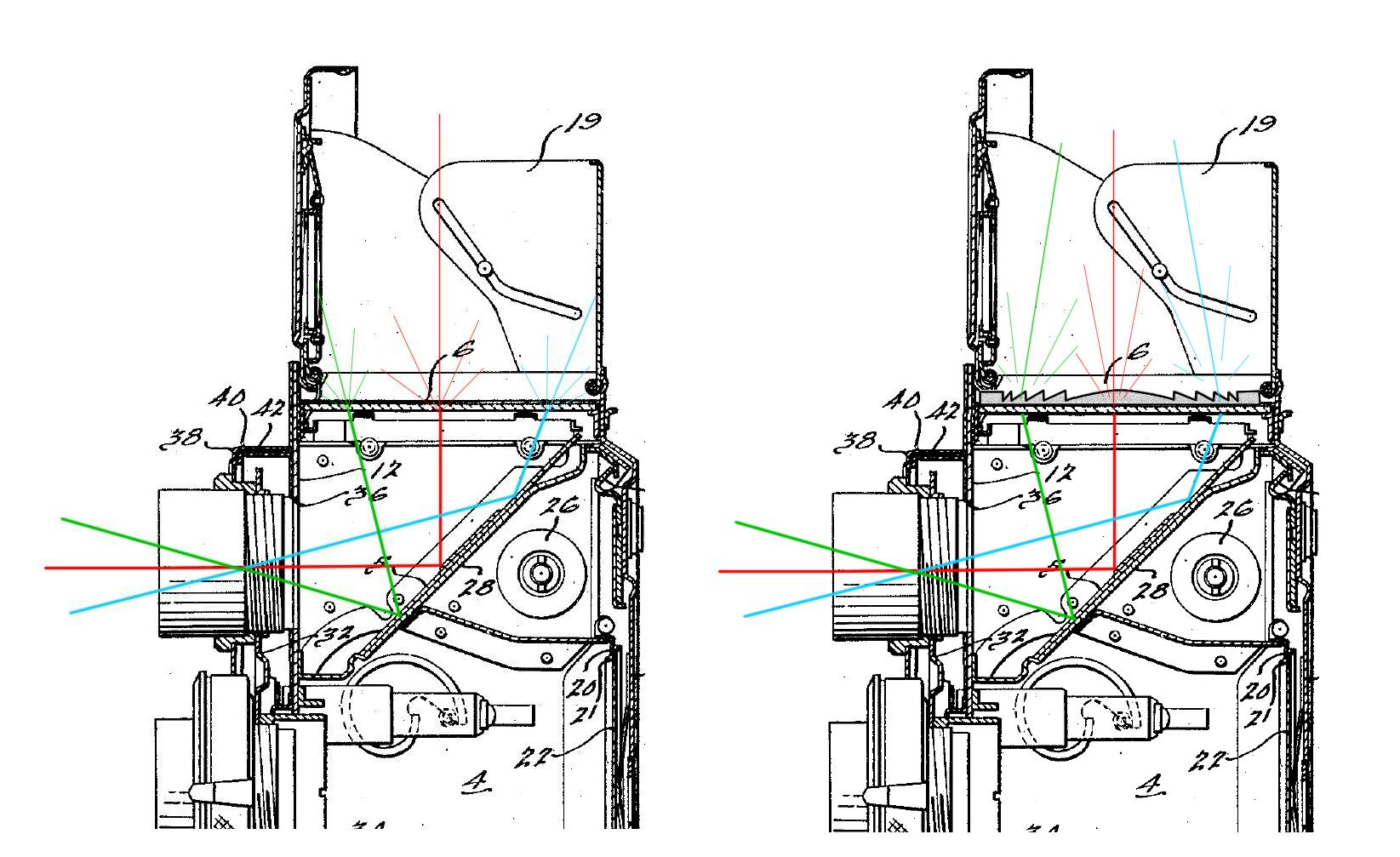|
||

On the left is a TLR with a plain groundglass, on the right the same TLR with a Fresnel lens added. The length and weight of the colored lines reflects the amount of light that each line represents. In both cases, light from the lens is scattered as it strikes the focusing surface - this is how the image is formed for focusing. As a result, most of the light passing through continues in a straight line, but a portion of it is scattered off in different directions. In the case of the plain groundglass, this results in most of the light reaching the eye for the central part of the image, but toward the edges the main portion of the light continues outward and is lost into the sides of the focusing hood - only a small part of the scattered light comes out in the direction of the user's eye. With the Fresnel lens, the light coming out of the screen is focused toward the eye. Some is still lost to scatter as before, but the main portion is directed toward the eye and only the scattered portion is lost. This is why a Fresnel screen appears brighter and more uniformly illuminated than a plain groundglass. Another way to increase apparent brightness is to reduce the amount of light that's lost to scatter at the focusing surface: press photographers sometimes smeared a little Vaseline on an area of the groundglass to create a brighter spot, and some bright screens have the surface treated to reduce scatter. HOWEVER, since it's the scatter that forms the focusing image, reducing scatter also reduces focusing precision.... and if done without the Fresnel lens, it makes the light falloff even worse in the outer field than it was with the plain groundglass. > Note that in the center, the Fresnel lens has little or no effect. The effect increases as you move toward the edge of the image, cancelling the light fall-off of the groundglass. >> A dim groundglass and a Fresnel bright screen both transmit the SAME amount of light (about 92% - actually, where the brighter screen is in 2 separate parts it transmits slightly less than the plain groundglass, due to the extra reflective surfaces). The difference is entirely in how the light is directed as it exits the screen. >>> For this reason, changing to a brighter screen may or may not affect a TTL meter reading - it depends on how the meter cells are designed and positioned. >>>> The Fresnel lens can be placed above or below the screen, it works either way. In many earlier factory installations the Fresnel lens was placed below the existing groundglass; in many later factory installations (and the BrightScreen), the screen is designed as one piece with the focusing surface on the bottom and the Fresnel on the top. The Rolleiflex "Rolleigrid" Fresnel accessory was a separate piece installed above the screen. >>>>> The lens does not have to be a Fresnel, a plano-convex condenser lens works the same way. Exakta 35mm SLRS and Pentacon Six used a glass condenser lens to increase brightness. The thick glass lens tends to introduce distortion into the view, and it's thick and heavy especially in larger formats. In many cases, both a Fresnel and a plano-convex condenser lens are used in the same screen... this is the case in the Mamiya M645, the Kowa SIx and the Nikon F. In the OM-1, Olympus made the pentaprism with its bottom face convex rather than flat, obtaining the benefits of the convex lens without the bulk; the interchangeable screen below the convex prism incorporated a Fresnel lens on its bottom surface and the focusing surface on the top. >>>>>> Typically, the focal length of the Fresnel lens is specified to correspond to the focal length (or the back focus) of the camera lens it is intended to be used with. However, a Fresnel lens can be designed with more than one focal length: because it's broken up into multiple facets, it's possible to have some of them representing one focal length, interspersed with others of a different focal length. Zeiss patented this idea in the 1950s, and the Brightscreen is designed this way. |
||
|
|
||
|
|
||
|
|
||
|
|
||
|
|
||
|
|
||
|
|
||
|
